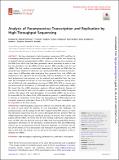Files in this item
Analysis of paramyxovirus transcription and replication by high-throughput sequencing
Item metadata
| dc.contributor.author | Wignall-Fleming, Elizabeth B. | |
| dc.contributor.author | Hughes, David J. | |
| dc.contributor.author | Vattipally, Sreenu | |
| dc.contributor.author | Modha, Sejal | |
| dc.contributor.author | Goodbourn, Steve | |
| dc.contributor.author | Davison, Andrew J. | |
| dc.contributor.author | Randall, Richard E. | |
| dc.date.accessioned | 2019-08-29T08:30:06Z | |
| dc.date.available | 2019-08-29T08:30:06Z | |
| dc.date.issued | 2019-08-13 | |
| dc.identifier | 259194079 | |
| dc.identifier | bfbc48f0-62bd-4fb0-899d-3bc50ca4d70d | |
| dc.identifier | 31189700 | |
| dc.identifier | 85069575790 | |
| dc.identifier | 000480712100009 | |
| dc.identifier.citation | Wignall-Fleming , E B , Hughes , D J , Vattipally , S , Modha , S , Goodbourn , S , Davison , A J & Randall , R E 2019 , ' Analysis of paramyxovirus transcription and replication by high-throughput sequencing ' , Journal of Virology , vol. 93 , no. 17 , e00571-19 . https://doi.org/10.1128/JVI.00571-19 | en |
| dc.identifier.issn | 0022-538X | |
| dc.identifier.other | ORCID: /0000-0002-0090-5710/work/58531631 | |
| dc.identifier.other | ORCID: /0000-0002-9304-6678/work/60426998 | |
| dc.identifier.other | ORCID: /0000-0002-3626-8768/work/60631227 | |
| dc.identifier.uri | https://hdl.handle.net/10023/18388 | |
| dc.description | This work was supported by the Wellcome Trust (grant nos. 101788/Z/13/Z, 101792/Z/13/Z and 109056/Z/15/A) and the Medical Research Council (grant no. G0801822, MRC-University of Glasgow Centre for Virus Research). | en |
| dc.description.abstract | We have developed a high-throughput sequencing (HTS) workflow for investigating paramyxovirus transcription and replication. We show that sequencing of oligo-dT selected polyadenylated mRNAs, without considering the orientation of the RNAs from which they had been generated, cannot accurately be used to analyse the abundance of viral mRNAs because genomic RNA co-purifies with the viral mRNAs. The best method is directional sequencing of infected cell RNA that has physically been depletion of ribosomal and mitochondrial RNA followed by bioinformatic steps to differentiate data originating from genomes from viral mRNAs and antigenomes. This approach has the advantage that the abundance of viral mRNA (and antigenomes) and genomes can be analysed and quantified from the same data. We investigated the kinetics of viral transcription and replication during infection of A549 cells with parainfluenza virus type 2 (PIV2), PIV3, PIV5 or mumps virus, and determined the abundance of individual viral mRNAs and readthrough mRNAs. We found that the mRNA abundance gradients differed significantly between all four viruses, but that for each virus the pattern remained relatively stable throughout infection. We suggest that rapid degradation of nonpolyadenylated mRNAs may be primarily responsible for the shape of the mRNA abundance gradient in parainfluenza virus 3, whereas a combination of this factor and disengagement of RNA polymerase at intergenic sequences, particularly those at the NP:P and P:M gene boundaries, may be responsible in the other viruses. | |
| dc.format.extent | 17 | |
| dc.format.extent | 2143481 | |
| dc.language.iso | eng | |
| dc.relation.ispartof | Journal of Virology | en |
| dc.subject | High-throughput sequencing | en |
| dc.subject | Paramyxovirus | en |
| dc.subject | Replication | en |
| dc.subject | Transcription | en |
| dc.subject | QH426 Genetics | en |
| dc.subject | QR355 Virology | en |
| dc.subject | R Medicine | en |
| dc.subject | NDAS | en |
| dc.subject.lcc | QH426 | en |
| dc.subject.lcc | QR355 | en |
| dc.subject.lcc | R | en |
| dc.title | Analysis of paramyxovirus transcription and replication by high-throughput sequencing | en |
| dc.type | Journal article | en |
| dc.contributor.sponsor | The Wellcome Trust | en |
| dc.contributor.institution | University of St Andrews. School of Biology | en |
| dc.contributor.institution | University of St Andrews. Biomedical Sciences Research Complex | en |
| dc.identifier.doi | 10.1128/JVI.00571-19 | |
| dc.description.status | Peer reviewed | en |
| dc.date.embargoedUntil | 2019-08-13 | |
| dc.identifier.grantnumber | 101788/Z/13/Z | en |
This item appears in the following Collection(s)
Items in the St Andrews Research Repository are protected by copyright, with all rights reserved, unless otherwise indicated.

